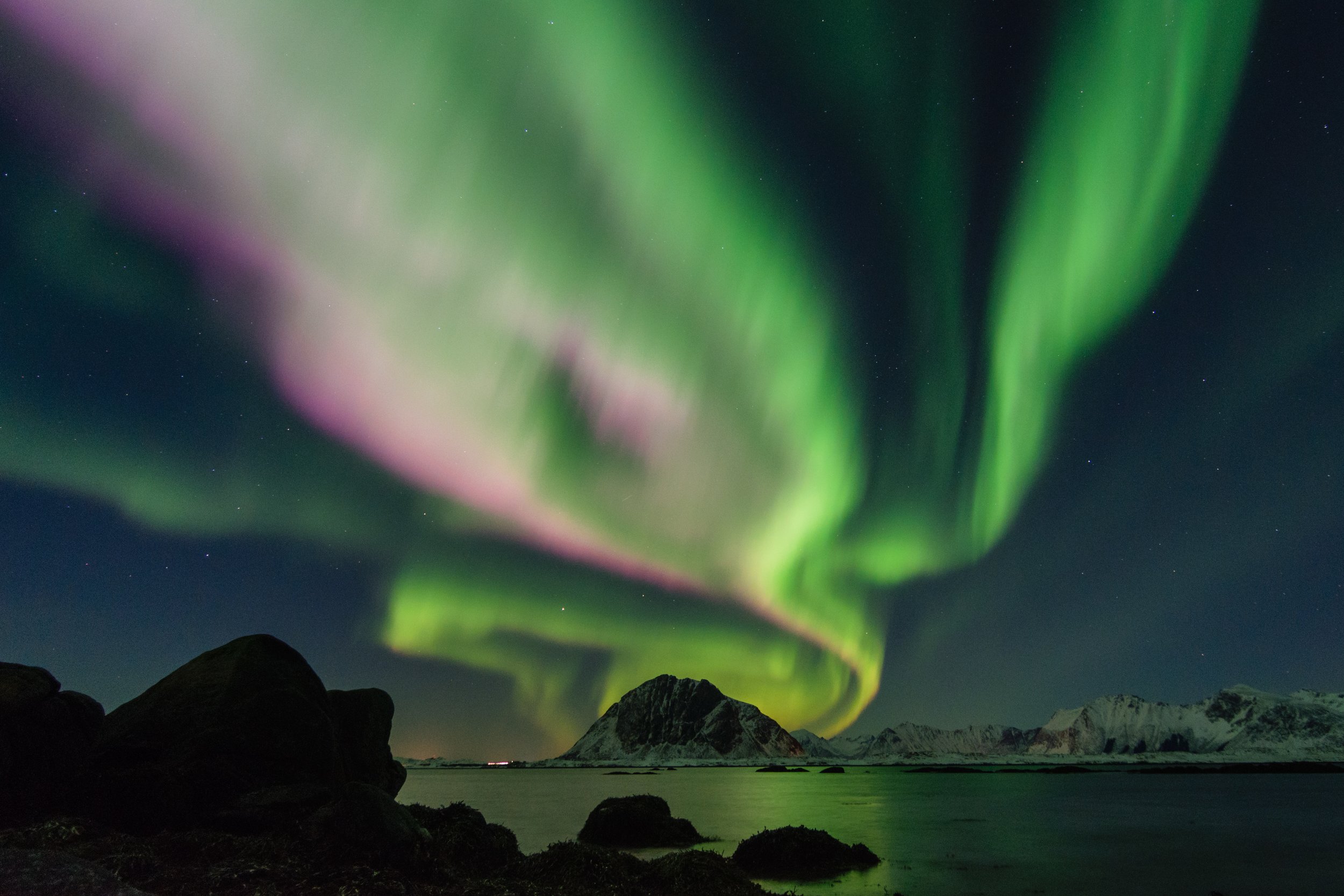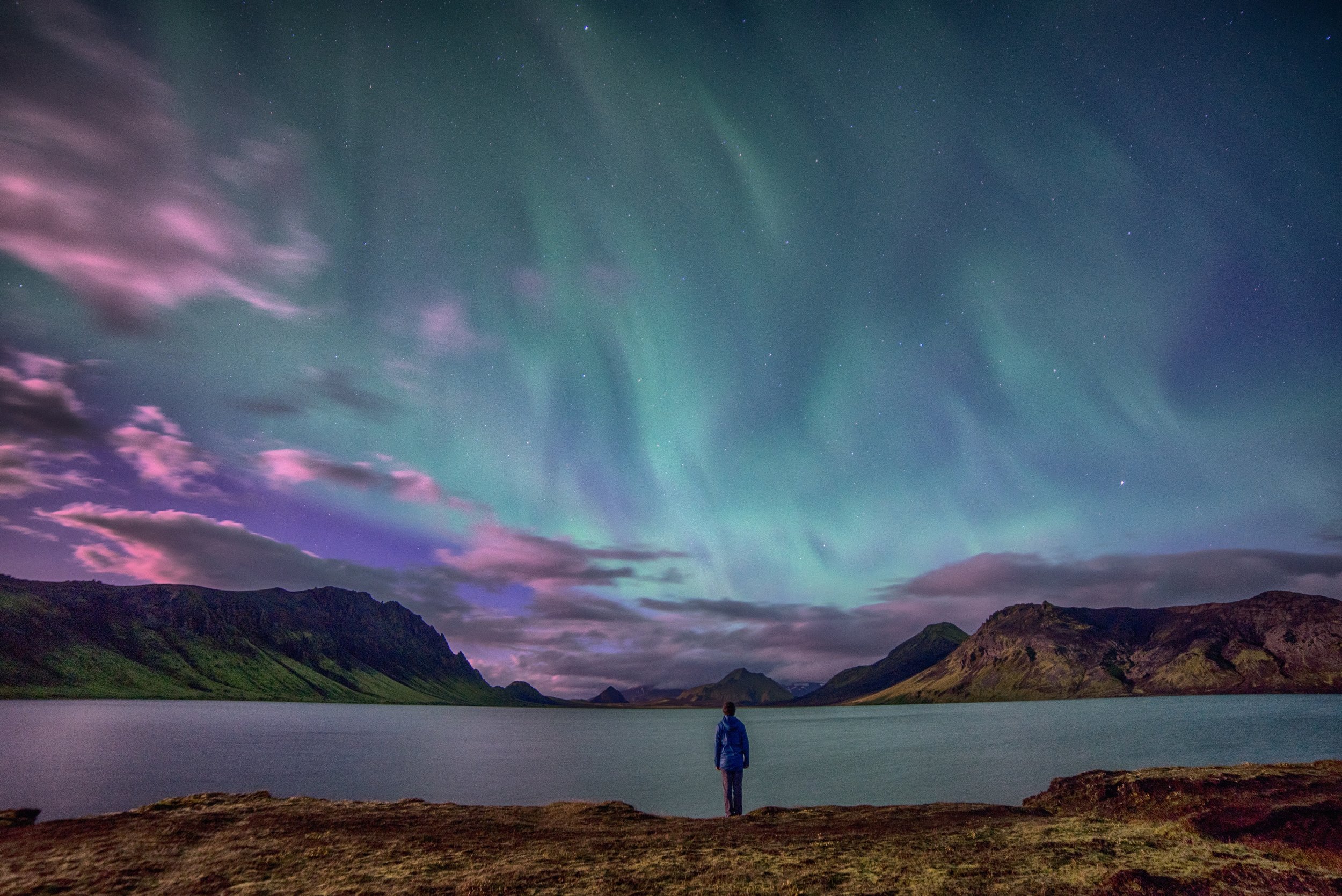THE BEST FACTS ABOUT THE NORTHERN LIGHTS
Seeing the Northern Lights should be a bucket list item for everyone.
And now, here's your chance.
Iceland is known for a lot of things...but above all, the Northern Lights are probably the most talked about. And for good reason. Every year, hundreds of thousands of tourists flock to Iceland to see these dramatic curtains of colored light, which appear high in the northern hemisphere and are illuminated by the sun's rays into what we know as, 'The Aurora Borealis.'
Ironically, the northern lights are most easily viewed in the most remote places, and are seen the most during the dead of winter in dimly lit locations. Iceland, of course, being one of the best places in the WORLD to see them, is our next destination tour happening in January 2018.
As it is, I wanted to bring to light (see what I did there?) some of the BEST facts about the Northern Lights and share some of the most captivating photos from a bit of the research I've gathered. So, without further a due, let's get to some fun facts.
1. Magnetic Fields and electrons are the main factors of the northern lights
The afterglow of the northern lights is a combination of collisions from fast-moving electrons from the 'magnetosphere,' a region of space controlled by Earth's magnetic field, full of oxygen and nitrogen. These electrons transfer some energy into the magnetosphere when they collide and releases photons or light particles, which are bright enough for the human eye to see.
Even though cameras catch the lights better than our own eyes, it's a very surreal experience to be beneath the Aurora Borealis....
2. Different Electrons Create Different Colors
The northern lights produce a variety of different colors in the night sky. Oxygen, for example, producesd a greenish-yellow or even red light, while nitrogen gives off a blue light. The two main components of the northern lights mix with each other to also give off purple, pink, and even white light. There's also a plethora of ultraviolet light, which can be detected by special cameras on satellites, but not by the hyuman eye. Perhaps that's why some high-def cameras can see the northern lights better than we can.
Overall, researchers can look at photos and identify the amounts of energy levels in the atoms in the magnetosphere. Pretty cool, eh?
3. The Aurora Borealis has been observed for a long time
The northern lights are not a new occurrence. Actually, they are a very old occurrence. They've been documented by some of history's most famous scholars, as well as Vikings, Native American tribes, and ancient civilizations. And for good reason, the northern lights are a serious thing to behold in person.
Galileo first observed the Northern Lights on full display in the year, 1621. And beyond that, a man named, 'Gregory of Tours' first wrote about them in modern years back in the 500's. And if you can believe that, the VERY FIRST written account of them before modern times was on a Babylonian clay tablet which belonged to the official astronomers of King Nebuchadnezzar the second, which was recorded on the night of March 12th, 567 BCE, who spoke of 'a faint red glow in the night sky.'
And if that wasn't enough, there are remnants of cave paintings dating back to 30,000 BCE which some believe to be representative of the Aurora Borealis....Oh, and of course other notable scholars who have seen them include Benjamin Franklin, who saw them in 1778 just after the Revolutionary War, and also, Edmond Halley, of comet fame, who saw and recorded them in 1716.
4. The Northern Lights Are Actually The Stories of Legends
The Northern Lights have been known as 'spirits' to old North American Inuit tribes, many of whom believed the lights are representations of sports figures in their society still playing up in the sky. Other legends include a belief that the aurora was a narrow, torch-lit pathway to guide departed souls to heaven, and the Igulik, who called the lights, 'Arsharneq' or 'Arshat' and thought they were powerful spirits who assisted shaman's here on earth. In other tribes, the northern lights were said to be the souls of powerful animals who were hunted and now live in the sky above....
Additionally, in Roman times, and throughout much of the Renaissance in Europe, people viewed the Northern Lights (especially red ones) as very frightening omens from the gods. The same kind of lore exists today for sailors around the world.
5. You can hear the Northern AND Southern Lights (yes, there are 'Southern Lights,' too)
The Northern Lights have a distinct counterpart known as the, 'Aurora Astralis,' that can be seen from the southern hemisphere in such places as Antartica, South America, New Zealand, and Australia. But since the South Pole isn't as accessible as up North, it becomes very difficult to view the Southern Aurora because you need some elevation to get a clear view. The Southern Lights are actually sometimes a little bit brighter, albeit, harder to find in most cases.
That's also why the Northern Lights get most of the attention from bucket-list travelers. Another fun fact, is the blue and green lights stemming from the aurora are formed at lower altitudes, while the orange, yellow and red shades are formed at higher altitudes in the magnetosphere.
6. There are 'Northern Lights' all over the solar system
The Northern Lights are a captivating experience for anyone who's lucky enough to view them in their lifetime. Whether you visit Iceland, Finland, Norway, Russia, Sweden, Greenland, Canada, Alaska, or somewhere else entirely, it's truly a breathtaking experience.
The crazy thing is, as unique of a situation as it is to see the Northern Lights, Earth isn't the only planet that boasts this spectacular phenomenon. As we now know, aurora's can not only be visibly observed from our own satellites of Earth, but they can be seen on other planets, too.
Most notably, Jupiter, Saturn, Neptune, Mars, and Uranus all have periodic episodes of a (sometimes much larger) aurora borealis. Read this post for more on what the aurora borealis looks like on other planets.
Another fun fact....on other planets in our solar system, the light creates a SOUND loud enough for us to hear through space. Isn't that crazy? Scientists have also literally described the sound similar to an, "Applause." Kind of appropriate, don't you think?
7. there's a plethora of things you can do beneath the northern lights
Iceland in particular has a plethora of bucket-list items you can do beneath the Northern Lights, and you can be picked up and dropped off right at the front door of our main hotel partner, City Park Hotel. Whether you want to go whale watching, see the Golden Circle, ride a skidoo across a glacier, go ice trekking, drive a quad beneath the northern lights, or simply soak in a hot spring and take in the view, we've got you covered on your next trip to Iceland.
Just imagine a week full of adventure, working out, going out, and seeing incredible views in remote places like this (above) while having a truly ethereal experience in Iceland. We're not kidding when we say there are SO MANY things to do, and whatever you end up choosing, it will all be worth it, trust us. You simply can't go wrong, and if you don't think the Northern Lights should be on your list, then I really think you should reconsider, because there's nothing in the WORLD like being beneath this sort of colorfully-filled crystal-clear sky. It's an enveloping experience and we can't WAIT to bring you here.
Plus, a whole week at CrossFit Reykjavik and you can drop-in anytime you want? What's better than that?
Have another fun fact you want to share with us? Post a comment down below, or email us at: staff@voyedgerx.com and we'll hope to see you on an upcoming Iceland tour. Don't forget to enter your email in at the bottom of the page!








